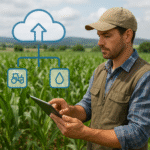As global temperatures continue to rise, the agricultural sector faces unprecedented challenges, driving the urgent need for climate-smart solutions. Farmers, researchers, and policymakers are collaborating to cultivate crops with enhanced resilience against heat, drought, and erratic rainfall. By leveraging cutting-edge technologies and traditional knowledge, this transformation in agriculture aims to secure food supplies and foster economic stability in vulnerable regions. The following sections explore three critical dimensions of this revolution: leveraging genetic diversity, deploying advanced precision agriculture tools, and adopting deeply sustainable farming practices.
Harnessing Genetic Diversity for Climate Resilience
Plant breeders are unlocking the potential of wild and landrace varieties to enhance modern cultivars. These ancestral relatives of staple crops often harbor latent traits—such as deep root systems, heat tolerance, and salt resistance—that confer survival advantages under stress. Through both conventional cross-breeding and modern biotechnology techniques like gene editing, researchers aim to stack multiple tolerance genes into elite lines, ensuring yield stability despite climatic fluctuations.
Gene Banks and Wild Relatives
Worldwide gene banks safeguard millions of seed samples, providing a repository of genetic traits that may become vital as conditions change. Examples include:
- Teosinte genes for improved maize root architecture
- Sorghum landraces with innate drought-tolerant mechanisms
- Wild rice species carrying flood resistance genes
CRISPR and Marker-Assisted Selection
While marker-assisted selection accelerates the identification of desirable traits, CRISPR/Cas9 offers pinpoint editing of genes responsible for stress responses. Scientists have successfully:
- Edited regulatory elements to boost expression of heat-shock proteins
- Knocked out susceptibility genes to combat fungal diseases exacerbated by humidity
- Introduced alleles linked to efficient water use and nutrient uptake
Combining these approaches ensures that next-generation varieties maintain high productivity under extreme temperatures, soil salinity, and water scarcity. Such multi-gene strategies also enhance long-term resilience, reducing dependence on external inputs like synthetic fertilizers and pesticides.
Advancements in Precision Agriculture and Digital Tools
The integration of data-driven methodologies has ushered in a new era of climate-smart farming. Precision agriculture technologies enable farmers to monitor field conditions at a granular level, applying inputs precisely when and where they are needed. This targeted approach optimizes resource use, lowers operational costs, and minimizes environmental footprints.
Remote Sensing and UAV Monitoring
Drones and satellite imagery provide real-time insights into crop health, soil moisture, and pest outbreaks. High-resolution multispectral cameras detect subtle variations in plant vigor, allowing early intervention. Benefits include:
- Timely adjustments to irrigation schedules based on actual soil moisture
- Early detection of nutrient deficiencies to prevent yield losses
- Identification of pest hotspots, reducing blanket pesticide applications
Soil Health and Variable-Rate Application
On-the-ground sensors measure parameters such as pH, temperature, and organic matter content. Coupled with GPS-guided machinery, farmers can execute:
- Variable-rate fertilization tailored to sub-field variability
- Precision tillage that preserves soil structure and soil health
- Automated nutrient management to support robust root development
Decision Support Systems and AI
Artificial intelligence platforms synthesize weather forecasts, historical yield data, and real-time field metrics to generate actionable recommendations. These systems empower stakeholders to:
- Forecast seasonal water requirements and schedule irrigation events
- Optimize planting dates to avoid heat waves or late frosts
- Simulate pest pressure scenarios and plan preventive measures
By leveraging big data analytics, farms can transition from reactive to proactive management, safeguarding crop performance under unpredictable climatic events and fostering long-term economic viability.
Integrating Sustainable Farming Practices to Mitigate Heat and Water Stress
Beyond genetics and technology, on-farm practices play a pivotal role in enhancing agricultural sustainability. Adopting holistic systems that conserve water, improve soil structure, and foster biodiversity creates an environment where crops can better withstand environmental extremes.
Agroforestry and Multistrata Systems
Incorporating trees into crop and livestock landscapes offers shade, reduces evapotranspiration, and enriches soils through leaf litter. Key advantages include:
- Microclimate regulation that moderates field temperatures
- Enhanced carbon sequestration, offsetting greenhouse emissions
- Additional income streams from timber, fruits, or fodder
Conservation Agriculture and Minimum Tillage
Practices that minimize soil disturbance preserve organic matter and maintain a protective mulch layer. Benefits are wide-ranging:
- Reduced water runoff and improved infiltration
- Stimulated activity of beneficial soil microorganisms
- Greater root penetration, fostering yield stability under drought
Integrated Water Management
Efficient water use is paramount for regions facing dwindling supplies. Innovative strategies include:
- Rainwater harvesting systems and on-farm reservoirs
- Drip and subsurface irrigation to minimize evaporation losses
- Use of soil amendments like biochar to enhance moisture retention
Crop Diversification and Intercropping
Growing multiple species in the same field spreads risk and exploits complementary interactions:
- Legume-cereal mixtures that enrich nitrogen levels naturally
- Cereal-pulse rotations to break pest and disease cycles
- Synthetic blends of early- and late-maturing varieties to stagger harvest
By embracing these integrated methods, farmers can build agroecosystems that are not only productive but also resilient to the stresses of global warming. Such landscapes serve as bulwarks against erosion, pest invasions, and yield volatility.
Reimagining the Future of Agriculture Under Climate Stress
In combining robust genetic diversity, cutting-edge precision agriculture technologies, and deeply ingrained sustainable practices, the agricultural community is charting a path toward global food security. As the climate continues to warm, the synergy of these strategies promises to safeguard harvests, conserve precious resources, and empower rural livelihoods. By fostering partnerships across sectors and investing in research and extension, stakeholders can scale up successful models and drive the adoption of climate-resilient cropping systems worldwide.










